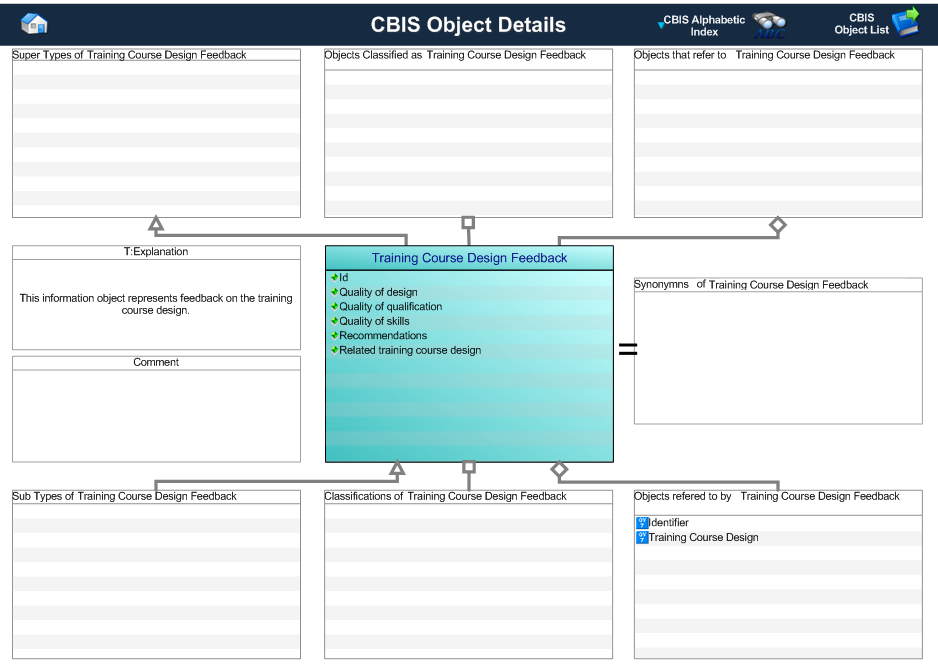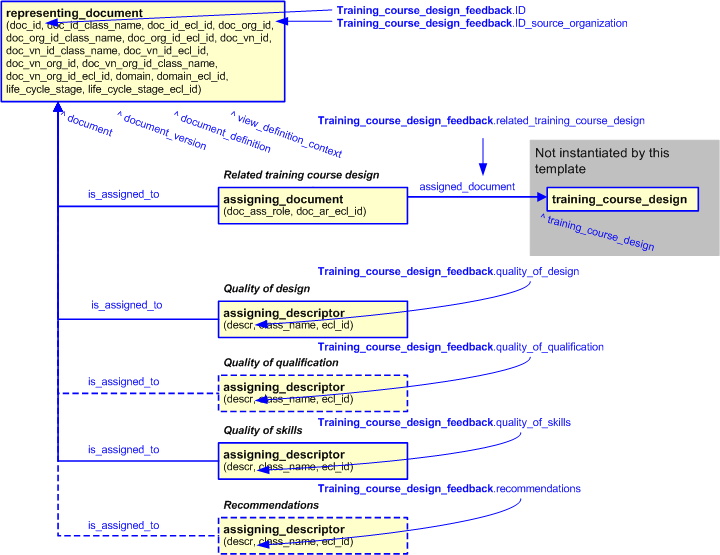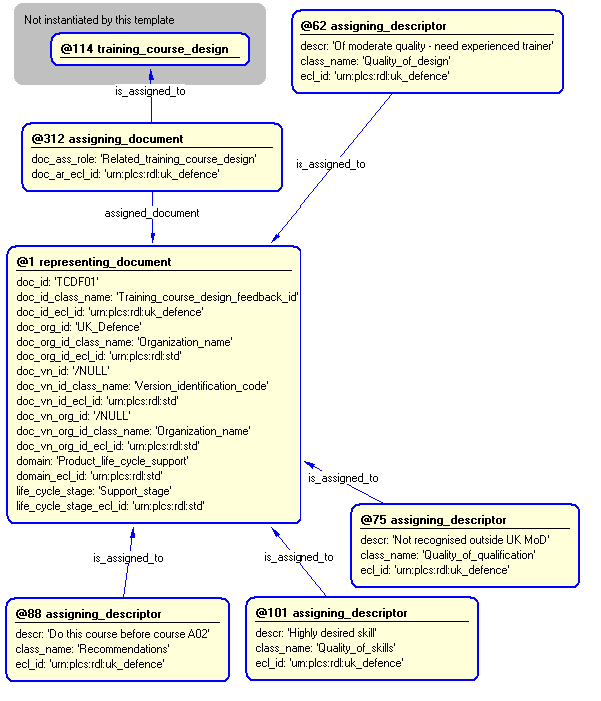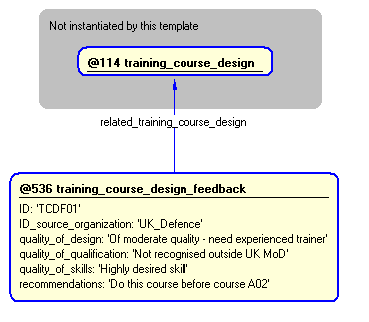Template:— training_course_design_feedback (trng_crs_des_fbk)
Context:— UK_Defence |
Date: 2010/02/24 20:00:50
Revision: 1.5
|
This section specifies the template training_course_design_feedback.
NOTE
The template has been defined in the context of
UK_Defence.
Refer to the business context for details of related templates.
NOTE
An explanation of a template and the associated instantiation path is
provided in the
Template overview
section.
This template describes how to represent feedback on the training course design.
This information object represents feedback on the training course design.
Figure 1 — Graphical Representation for Business Object Training Course Design Feedback
Training Course Design Feedback:
|
Attribute name
|
Attribute description
|
Attribute type
|
Optionality
|
| ID |
This is the identifier of the training course design feedback |
intrinsic |
Mandatory |
| Quality of design |
This is the description of the quality of the training course design |
intrinsic |
Mandatory |
| Quality of qualification |
This is the description of the quality qualification gained from this training course design |
intrinsic |
Optional |
| Quality of skills |
This is the description of the quality of the skills gained from this training course design. |
intrinsic |
Mandatory |
| Recommendations |
This is the description of the recommendations made as part of the feedback on the training course design. |
intrinsic |
Optional |
| Related training course design |
This is the reference to the related training course design. |
Relationship to Training Course Design |
Mandatory |
Table 1 — Training Course Design Feedback attribute details:
The EXPRESS-G diagram in
Figure
2
shows the templates and EXPRESS entities that are required
to represent the template
"training_course_design_feedback".
The text highlighted in blue shows the template parameters.
Figure 2 — An EXPRESS-G representation of the Information model for training_course_design_feedback
The graphic for the template to be used in other EXPRESS-G diagrams
is shown in Figure
3
below.
Figure 3 — The graphical representation of the training_course_design_feedback template
The following input parameters are defined for this template:
This is the identifier of the training course design feedback.
The organization that created the identifier. Additionally
a Person or Information System could be defined when either of these are the source; see Identifier template.
This is the description of the quality of the training course design
This is the description of the quality qualification gained from this training course design
This is the description of the quality of the skills gained from this training course design.
This is the description of the recommendations made as part of the feedback on the training course design.
This is the reference to the related training course design.
The following reference parameters are defined for this template:
Allow the
Document
entity instantiated in this path to be referenced when this template is used.
Note: The
Document
entity can be referenced in a template path by:
%^target = $training_course_design_feedback.training_course_design_feedback%
where
target
is the parameter to which the
Document
is bound.
The following parameter combinations specify a uniqueness constraint:
Unique constraint: Training_course_design_feedback
Each instance of the
entity
(
Document)
within the data set shall be uniquely identified
by the following parameters on this
template (training_course_design_feedback) namely:
ID.
The
instance is
referenced by the following template parameter:
training_course_design_feedback.
The instantiation path shown below specifies the entities that are to be
instantiated by the template.
A description of templates and the syntax for the instantiation path is
provided in the
Templates Help/Information section.
-- Representing document /
representing_document(
doc_id=@ID,
doc_id_class_name='Training_course_design_feedback_identifier',
doc_id_ecl_id='urn:plcs:rdl:uk_defence',
doc_org_id=@ID_source_organization,
doc_org_id_class_name='Organization_name_or_identification_code',
doc_org_id_ecl_id='urn:plcs:rdl:uk_defence',
doc_vn_id=/NULL,
doc_vn_id_class_name='Version_identification_code',
doc_vn_id_ecl_id='urn:plcs:rdl:std',
doc_vn_org_id='/NULL',
doc_vn_org_id_class_name='Organization_name',
doc_vn_org_id_ecl_id='urn:plcs:rdl:std',
domain='Product_life_cycle_support',
domain_ecl_id='urn:plcs:rdl:std',
life_cycle_stage='Support_stage',
life_cycle_stage_ecl_id='urn:plcs:rdl:std')/
%^training_course_design_feedback = $representing_document.document%
-- quality_of_design /
assigning_descriptor(
descr=@quality_of_design,
class_name='Quality_of_design',
ecl_id='urn:plcs:rdl:uk_defence',
is_assigned_to=^training_course_design_feedback)/
-- [optional quality_of_qualification] /
assigning_descriptor(
descr=@quality_of_qualification,
class_name='Quality_of_qualification',
ecl_id='urn:plcs:rdl:uk_defence',
is_assigned_to=^training_course_design_feedback)/
-- quality_of_skills /
assigning_descriptor(
descr=@quality_of_skills,
class_name='Quality_of_skill',
ecl_id='urn:plcs:rdl:uk_defence',
is_assigned_to=^training_course_design_feedback)/
-- [optional recommendations] /
assigning_descriptor(
descr=@recommendations,
class_name='Recommendation',
ecl_id='urn:plcs:rdl:uk_defence',
is_assigned_to=^training_course_design_feedback)/
-- related_training_course_design /
assigning_document(
assigned_document=^training_course_design_feedback,
doc_ass_role='Related_training_course_design',
doc_ar_ecl_id='urn:plcs:rdl:uk_defence',
is_assigned_to=@related_training_course_design)/
The instance diagram in Figure
4
shows an example of the EXPRESS entities and templates that are instantiated by the template:
/training_course_design_feedback(ID='TCDF01', ID_source_organization='UK_Defence', quality_of_design='Of moderate quality - need experienced trainer', quality_of_qualification='Not recognised outside UK MoD', quality_of_skills='Highly desired skill', recommendations='Do this course before course A02', related_training_course_design='@114')/
(an illustration of the consolidated training_course_design_feedback template is shown in
Figure
5 below.)
Figure 4 — Entities instantiated by training_course_design_feedback template
The instance diagram in
Figure
5
shows the graphic symbol for the template that is to be
used in other instance diagrams. The example template is:
/training_course_design_feedback(ID='TCDF01', ID_source_organization='UK_Defence', quality_of_design='Of moderate quality - need experienced trainer', quality_of_qualification='Not recognised outside UK MoD', quality_of_skills='Highly desired skill', recommendations='Do this course before course A02', related_training_course_design='@114')/
Figure 5 — Instantiation of training_course_design_feedback template
Characterizations
No common characterizations of the template
training_course_design_feedback
have been identified. However, the ISO 10303-239 EXPRESS model
may enable other assignments to the entities instantiated by the template.




